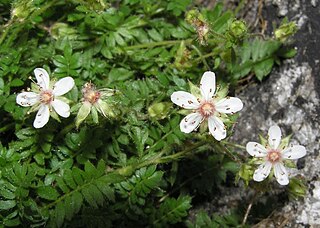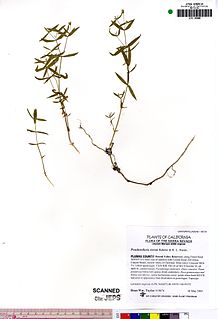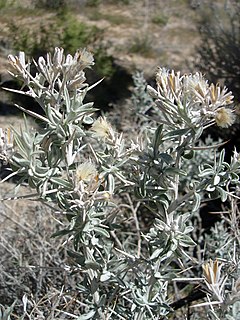
Ipomopsis arizonica is a flowering plant in the family Polemoniaceae, native to the mountains of the Mojave Desert sky islands from southeastern California east through southern Nevada to northern Arizona, growing at 1500–3100 meters in elevation. It is found in rocky places in the desert, as well as washes.

Cerastium arvense is a species of flowering plant in the pink family known by the common names field mouse-ear and field chickweed. It is a widespread species, occurring throughout Europe and North America, as well as parts of South America. It is a variable species. There are several subspecies, but the number and defining characteristics are disputed.
Iliamna latibracteata is an uncommon species of flowering plant in the mallow family known by the common names California globe mallow and California wild hollyhock.

Ivesia callida is a rare species of flowering plant in the rose family known by the common name Tahquitz mousetail. It is endemic to the San Jacinto Mountains of Riverside County, California, where it is known from only two occurrences. The plant grows in cracks and crevices of the granite mountain cliffs. It was named for Tahquitz, a rock formation in its endemic range. This is a small perennial herb which forms matted patches of hanging foliage on cliff faces. The leaves are strips of oval-shaped green leaflets. Each leaf is up to 7 centimeters long and has several pairs of hairy, glandular leaflets. The thin, green, hanging stems are up to 15 centimeters long and bears an inflorescence of several flowers. Each flower has five hairy, pointed sepals and five rounded to oval white petals. The center of the flower contains twenty stamens with disc-shaped anthers and several pistils.

Ivesia webberi is a species of flowering plant in the rose family known by the common names wire mousetail and Webber's ivesia. It is native to the United States, where it occurs in the northernmost part of the Sierra Nevada and the adjacent Modoc Plateau in California, its range extending just into Nevada.

Bolandra californica is a species of flowering plant in the saxifrage family, known by the common names Sierra bolandra and Sierra false coolwort. It is one of two species in the small genus Bolandra. It is endemic to the High Sierra Nevada of California, where it is an uncommon member of the coniferous forest understory.

Cryptantha flavoculata is a species of flowering plant in the borage family known by the common name roughseed cryptantha. It is native to the western United States from California to Montana, where it is common in many types of habitat. It is a perennial herb growing an unbranching stem up to about 35 centimeters tall from a woody caudex. It is coated in soft bristly hairs. The densely hairy to bristly leaves vary in shape and may reach 11 centimeters long. The inflorescence is a cylindrical cluster or rounded head of flowers which elongates as the fruits develop from the bottom up. Each tubular flower is about a centimeter long topped with a five-lobed white corolla with yellow appendages at the center.
Minuartia rosei is an uncommon species of flowering plant in the family Caryophyllaceae known by the common names peanut sandwort and peanut stitchwort.
Monardella palmeri is a species of flowering plant in the mint family known by the common name Palmer's monardella.

Pholistoma racemosum is a species of flowering plant in the borage family which is known by the common name racemose fiesta flower, racemed fiestaflower, and San Diego fiestaflower. It is native to southern California, including the Channel Islands, and Baja California, where it can be found in coastal areas and in the coastal mountains and canyons, often in moist, shady areas.
Plagiobothrys distantiflorus is a species of flowering plant in the borage family known by the common name California popcornflower. It is endemic to California, where it is known only from the northern and central Sierra Nevada foothills.

Pseudostellaria sierrae is a species of flowering plant in the family Caryophyllaceae known by the common name Sierra starwort.

Senna didymobotrya is a species of flowering plant in the legume family known by the common names African senna, popcorn senna, candelabra tree, and peanut butter cassia. It is native to Africa, where it can be found across the continent in several types of habitat.

Stellaria calycantha is a species of flowering plant in the family Caryophyllaceae known by the common name northern starwort. It is native to western North America from Alaska and northwestern Canada to California and New Mexico, as well as eastern Russia. It occurs in subalpine and alpine climates, in many types of moist, shady habitat. It is a rhizomatous perennial herb producing a prostrate to erect stem up to 25 centimeters long, taking a clumpy form. The thin oval leaves have smooth edges and pointed tips, and measure up to 2.5 centimeters in length. The inflorescence bears one or more flowers, each on a long pedicel. Each flower has five pointed green sepals, and some flowers have up to five deeply lobed white petals.
Streptanthus callistus is a rare species of flowering plant in the mustard family known by the common name Mount Hamilton jewelflower. It is endemic to Santa Clara County, California, where it is known from only about five occurrences around Mount Hamilton. It grows in chaparral and woodlands and on dry scree. It is an annual herb producing a small stem up to 8 or 9 centimeters tall with a bristly base. The toothed oval leaves are under 2 centimeters long. The inflorescence is a cluster-like raceme of flowers, the top ones sterile. The fertile flowers on the lower raceme have calyces of bristly purple-green sepals under a centimeter long with flaring purple petals at the tip. The sterile flowers at the top of the raceme have narrow, elongated, hairless purple sepals. The fruit is a cylindrical, bristle-studded silique measuring up to 2 or 2.5 centimeters long.

Tetradymia stenolepis is a species of flowering plant in the aster family known by the common name Mojave cottonthorn. It is native to the deserts around the intersection of Arizona, Nevada, and eastern California, where it grows in woodland and scrub habitat on sandy and gravelly substrates. It is a bushy shrub with many branches coated in woolly white fibers and growing to a maximum height just over a meter. The narrow leaves are 2 or 3 centimeters long and harden into straight, sharp spines. Clusters of woolly leaves grow near the spines. The inflorescence bears up to 7 flower heads which are each enveloped in four or five woolly phyllaries. Each head contains up to four or five tubular yellow flowers each around a centimeter long. The fruit is a hairy achene which may be nearly 2 centimeters long, including its pappus of long bristles.
Tetradymia tetrameres is a species of flowering plant in the aster family known by the common name fourpart horsebrush and dune horsebrush. It is native to the Great Basin, where it occurs in western Nevada and just over the border in Mono County, California. It is a plant of dry scrub and sand dunes. It is a bushy, woolly shrub with many erect, spineless branches. It is the largest of the horsebrushes, growing up to two meters in height. The soft, woolly leaves are narrow and threadlike, growing up to 4 centimeters long. Shorter leaves occur in clusters around the primary leaves. The inflorescence bears 4 to 6 flower heads which are each enveloped in four or five woolly phyllaries. Each head contains up to four or five light yellow flowers each around a centimeter long. The fruit is a hairy achene which may be up to a centimeter long, including its pappus of long bristles.

Velezia rigida is a species of flowering plant in the family Caryophyllaceae. It is native to southern Europe. It is also present in northern California where it is an introduced species. It is an annual herb growing from a taproot and producing a hairy, glandular, branching green or purplish stem up to 40 centimeters tall. The linear leaves are up to 2 centimeters long. Solitary flowers occur in the leaf axils. Each flower has a very long, cylindrical, ribbed calyx of fused sepals forming the tubular throat of the flower, measuring at least a centimeter in length. At the top of the tube is the flower corolla which has five pink or purplish petals.

Calochortus syntrophus is a rare species of flowering plant in the lily family known by the common names Callahan's mariposa lily and clustered mariposa lily. It is endemic to northern California, where it occurs in a remote area north of Montgomery Creek in Shasta County. It has also been spotted in adjacent Tehama County. Its habitat includes open, rocky areas with moist or wet soils in oak woodland territory. It was first discovered in 1993 and its description was published the following year.

Micranthes californica, known by the common name California saxifrage, is a species of flowering plants.















